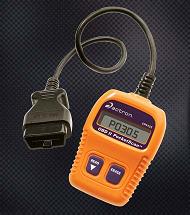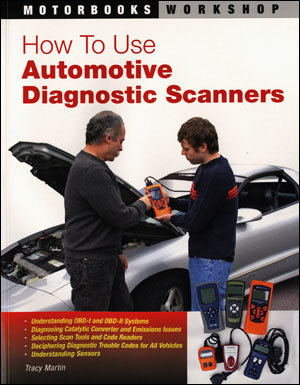Reader & Scanner FAQ
 |
Actron PocketScan |
|
 |
How to Use Automotive |
You're driving along, and that little light on your dash comes on. What do you do? The "check engine" light can mean many different things, from a loose gas cap to a seriously misfiring engine. Your vehicle's computer has detected a problem and it stores a "trouble code" in its memory that identifies the source of the problem.
With your own diagnostic scan tool, you can connect to your vehicle to read that trouble code. This is the first step in diagnosing the problem.
What is the difference between a Reader and a Scanner? Readers and Scanners both display vehicle computer fault codes with descriptions. Scanners have the additional function of providing real-time component voltage and current outputs. Some examples of these components are: 02 Sensors, Fuel Injectors, Throttle Position Sensors, and Transmission Sensors. Examples of Code Readers are the Actron CP9125 PocketScan and the AutoXray 2000 EZ-Scan. Examples of Code Scanners are the Actron CP9145 AutoScanner and the AutoXray 4000 EZ-Scan.
What is the difference between OBD I & OBD II (On-Board Diagnostic I & II)? OBD I refers to most domestic cars manufactured 1981 – 1995. Before OBD II was enforced, manufacturers used different data link connectors to communicate with the vehicles.
OBD II covers all passenger cars and light trucks built for sale in the U.S. 1996-present. Any vehicle with a GVW (Gross Vehicle Weight) up to 8,500 has to be OBDII Compliant (California GVW 1400). Any vehicle over the GVW of 8,500 (i.e. Medium/Heavy Duty trucks) may not be compliant - This information can be found on a sticker located on the driver's doorframe.
What are
generic OBD II codes?
Generic OBD II Diagnostic
Trouble Codes are common for any OBD II compliant vehicle,
be it Domestic, Asian or European. These codes are
sometimes called "P-codes" and typically begin with "P0" or
"P2".
What are enhanced OBD II codes?
Enhanced OBD II Diagnostic Trouble Codes are unique to a
vehicle of a specific year, make, model (and possibly engine
size). They are assigned by the vehicle manufacturers to
cover situations not already covered by a Generic DTC. These
codes typically begin with "P1".
Will these Code Scanners and/or Scan Tools retrieve Anti-Lock Brake or Airbag codes? The OTC Genisys and Nemisys can retrieve ABS and Airbag codes. However, most do-it-yourself level tools retrieve Diagnostic Trouble Codes (DTCs) from the Powertrain controller (engine computer) only. Some exceptions are the OTC3111 and the Actron CP9580, which have ABS code read/erase capability for most 1996 and newer GM, Ford and Chrysler vehicles. The Actron CP9449 is specifically an ABS tool and is compatible with most OBDII domestic vehicles 1996 - 2005.
What about Diesel Engines? Actron tools will do well with the Chrysler and GM Diesel vehicles that are OBDII compliant. There are some issues with the Ford diesels, especially the F-250's and up. AutoXRay tools do not do well with diesels of any sort except the smaller import vehicle diesel engines (i.e. VW).
Most of the do-it-yourself level scanners will
not connect to Chevy Duramax and Ford Powerstroke diesel vehicles because their
GVW exceeds the maximum requirements of the OBDII standard. Since these
trucks are not officially OBDII compliant, most scanners will only give you a
very limited amount of data. If you have one of these trucks, we recommend
either the OTC3499N tool or the AutoEnginuity scanner with the appropriate enhanced software package.


 Cart
Cart

